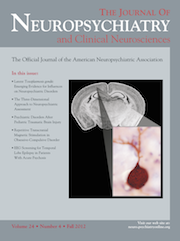Aripiprazole Augmentation for Clozapine-Associated Tardive Torticollis
To The Editor: Clozapine-associated tardive dystonia has been rarely reported.1,2 Tardive dystonia is often related to typical antipsychotics and may be relieved by clozapine. Hence, the treatment of clozapine-related tardive dystonia poses a great challenge for clinicians. We report a woman showing clozapine-associated tardive torticollis, which was successfully treated with aripiprazole augmentation.
"Ms. M," a 42-year-old woman, was admitted with treatment-refractory schizophrenia. She was given full dose of aripiprazole, paliperidone, quetiapine, and amisulpiride, as well as electroconvulsive therapy (ECT), with limited improvement. Because of refractory psychotic symptoms, clozapine was gradually increased from 25 mg/day to 375 mg/day within 1½ months. However, her physical examination revealed tonic flexion of the neck to the right, with medial rotation. She had no other neurological deficits and no history of dystonia. The angle between the head and spine increased to 60° in the next 3 weeks. Ms. M received biperiden 8 mg/day and clonazepam 4 mg/day while the clozapine dose was tapered to 250 mg/day. However, her torticollis persisted, and psychotic symptoms were aggravated. We added aripiprazole 15 mg/day for 2 weeks, and the torticollis partially improved. It did not worsen when we increased clozapine to 325 mg/day in the next 2 weeks. The bending angle decreased from 15° to 0° when we increased aripiprazole to 30 mg/day for another 4 weeks. Her psychotic symptoms were also better controlled.
This is the first report about clozapine-associated tardive dystonia subsiding under aripiprazole augmentation. Clozapine was considered less likely to cause extrapyramidal symptoms because of its high 5-HT2A/D2 affinity ratio and rapid dissociation of D2 antagonism. Previous literature on clozapine-associated tardive dystonia identified risk factors including combined psychotropics, old age, female gender, and organic brain syndrome.2,3 In Ms. M’s case, she had only one risk factor: female gender. Antipsychotics other than clozapine had been discontinued for more than 1 month before the onset of her torticollis, which would not be explained by cholinergic–dopaminergic imbalance during rapid discontinuation of antipsychotics. ECT was administered 2 months before clozapine treatment and also less likely to cause torticollis.
Ms. M’s tardive torticollis responded to the augmentation with aripiprazole, while anticholinergics and benzodiazepines all failed. Aripiprazole is a dopamine partial agonist, which mainly binds to D2 receptors, and also shows properties of D3 antagonist, 5-HT1A partial agonist, and 5-HT2A antagonist. A previous report suggests that aripiprazole might correct the dopaminergic imbalance in the condition of Pisa syndrome.4 Our report supports the role of a dopamine partial agonist in treating tardive dystonia and waiving the invasive treatment of botulinum toxin A injection.
1 : The current status of tardive dystonia. Biol Psychiatry 1999; 45:715–730Crossref, Medline, Google Scholar
2 : Pisa syndrome and atypical antipsychotics. Am J Psychiatry 2004; 161:373Crossref, Medline, Google Scholar
3 : Pisa syndrome (pleurothotonus): report of a multicenter drug safety surveillance project. J Clin Psychiatry 2000; 61:569–574Crossref, Medline, Google Scholar
4 : Improvement in Pisa syndrome and tardive dyskinesia following aripiprazole treatment. J Neuropsychiatry Clin Neurosci 2009; 21:350–351Link, Google Scholar



